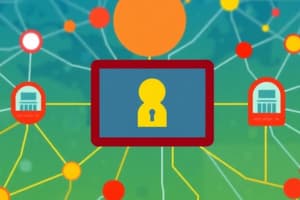Podcast
Questions and Answers
କେଉଁଟି Network Security ର ଅଂଶ କିମ୍ବା ସେବା ନୁହେଁ?
କେଉଁଟି Network Security ର ଅଂଶ କିମ୍ବା ସେବା ନୁହେଁ?
- VPN
- Antivirus Software
- Encryption
- Web Browsing (correct)
OSI Model ର କେତେଟି ତଳ ରହିଛି?
OSI Model ର କେତେଟି ତଳ ରହିଛି?
- 4
- 5
- 6
- 7 (correct)
DHCP କଣ କରେ?
DHCP କଣ କରେ?
- IP addresses ସ୍ୱୟଂକ୍ରିୟ ସୂଚିକରଣ କରିବା (correct)
- କ୍ଷେତ୍ର ଏବଂ ବ୍ରାଉଜର ସଂଯୋଗ କରିବା
- ସେବା ମାଧ୍ୟମରୈଣ ହେଉଗଳା
- ଇନ୍ଟରନେଟ ଏବଂ ସଂଯୋଗ ବନ୍ଧନ କରିବା
କେଉଁଟି ଡାଟା ପ୍ରେଷଣ ପ୍ରକାର ମଧ୍ୟରେ ନୁହେଁ?
କେଉଁଟି ଡାଟା ପ୍ରେଷଣ ପ୍ରକାର ମଧ୍ୟରେ ନୁହେଁ?
TCP/IP Model ର କେତେଟି ତଳ ଅଛି?
TCP/IP Model ର କେତେଟି ତଳ ଅଛି?
Flashcards are hidden until you start studying
Study Notes
Networking Principles
-
Definition
- Networking refers to connecting computers and other devices to share resources and information.
-
Types of Networks
- LAN (Local Area Network): Covers a small geographical area, like a home or office.
- WAN (Wide Area Network): Covers a large geographical area, can connect multiple LANs.
- MAN (Metropolitan Area Network): A network that spans a city or a large campus.
- PAN (Personal Area Network): A network for personal devices, typically within a range of a few meters.
-
Network Topologies
- Star: Central hub with all nodes connected individually.
- Bus: All nodes share a single communication line.
- Ring: Each node connected to two others, forming a circular data path.
- Mesh: Nodes interconnected, providing multiple pathways for data.
-
Network Protocols
- TCP/IP (Transmission Control Protocol/Internet Protocol): Fundamental suite for internet communication.
- HTTP/HTTPS (HyperText Transfer Protocol/Secure): Used for transferring web pages.
- FTP (File Transfer Protocol): Used for transferring files over a network.
- SMTP (Simple Mail Transfer Protocol): Used for sending emails.
-
Networking Devices
- Router: Connects different networks and directs data traffic.
- Switch: Connects devices within the same network, using MAC addresses to forward data.
- Hub: Basic device that connects multiple Ethernet devices, broadcasting data to all ports.
- Modem: Modulates and demodulates signals for communication over telephone lines or cable.
-
IP Addressing
- IPv4: 32-bit address, formatted as four decimal numbers (e.g., 192.168.1.1).
- IPv6: 128-bit address, designed to replace IPv4 due to the exhaustion of addresses.
- Static IP: Fixed address that doesn’t change.
- Dynamic IP: Temporarily assigned address, changes periodically.
-
Network Security
- Firewalls: Monitor and control incoming and outgoing network traffic based on security rules.
- Antivirus Software: Protects networked systems from malware and other threats.
- Encryption: Secures data by encoding it, making it unreadable without a key.
- VPN (Virtual Private Network): Creates a secure connection over the internet, used for remote access.
-
Data Transmission Methods
- Wired: Uses physical cables (Ethernet, Fiber Optic).
- Wireless: Uses radio waves (Wi-Fi, Bluetooth).
-
Network Models
- OSI Model (Open Systems Interconnection): 7-layer model for understanding network interactions:
- Physical
- Data Link
- Network
- Transport
- Session
- Presentation
- Application
- TCP/IP Model: 4-layer model simplifying the OSI model:
- Link
- Internet
- Transport
- Application
- OSI Model (Open Systems Interconnection): 7-layer model for understanding network interactions:
-
Common Networking Services
- DHCP (Dynamic Host Configuration Protocol): Automatically assigns IP addresses to devices on a network.
- DNS (Domain Name System): Translates domain names into IP addresses.
These principles form the foundation for understanding how computer networks operate and are essential for effective communication and data exchange in modern computing environments.
networking ସିଦ୍ଧାନ୍ତ
- ନେଟୱର୍କିଂ ଅର୍ଥ
- ନେଟୱର୍କିଂ କମ୍ପ୍ୟୁଟର ଓ ଅନ୍ୟ ଯନ୍ତ୍ରମାନେ ଆଧାର ଗଠନ କରିବା ଓ ସଂସାଧନ ଓ ସୂଚନା ଅଂଶାଦାନ କରିବାରେ।
ନେଟୱର୍କର ପ୍ରକାର
-
LAN (Local Area Network)
- କ୍ଷୁଦ୍ର ଭୌଗୋଲିକ କ୍ଷେତ୍ର, ଯାହା ଘର କିମ୍ବା କାର୍ଯ୍ୟଳୟକୁ କାୟକ୍ଷମ କରେ।
-
WAN (Wide Area Network)
- ବଡ ଭୌଗୋଲିକ କ୍ଷେତ୍ର, ଯାହା ଏକାଧିକ LAN ସହ ସଂଯୋଗ କରେ।
-
MAN (Metropolitan Area Network)
- ଏକ ସହର କିମ୍ବା ବଡ କ୍ୟାମ୍ପସରେ ବିସ୍ତାର ହୋଇଥିବା ନେଟୱର୍କ।
-
PAN (Personal Area Network)
- ବ୍ୟକ୍ତିଗତ ଯନ୍ତ୍ରମାନେ ମଧ୍ୟରେ ସଂଯୋଗ, ସାଧାରଣତଃ କିଛି ମିଟାର ମଦ୍ୟରେ।
ନେଟୱର୍କ ଟପୋଲଜି ସ୍କଳା
-
Star
- ମୁଖ୍ୟ ହବ୍ ପରି ଏହା ସମସ୍ତ ନୋଡ୍ଗୁଡିକୁ ବ୍ୟକ୍ତିଗତ ଭାବରେ ସଂଯୋଗ କରେ।
-
Bus
- ସମସ୍ତ ନୋଡ୍ ଗୁଡିକ ଏକ ଏକାକାର ସଂଯୋଗ ଶ୍ରେଣୀକୁ ସେୟାର କରେ।
-
Ring
- ପ୍ରତ୍ୟେକ ନୋଡ୍ ଦୁଇଟି ଅନ୍ୟ ନୋଡ୍ ସହ ସଂଯୋଗ ହୋଇଦେଖା।
-
Mesh
- ନୋଡ୍ଗୁଡିକ ଅନ୍ତର୍ଜ୍ଞାନ ଭାବେ ସଂଯୋଗିତ ହୋଇଥାଏ, ତାହା ସହ ଡାଟା ପାଇଁ ବହୁତ ପଥ ଦେଇଥାଏ।
ନେଟୱର୍କ ପ୍ରୋଟୋକଲ୍
-
TCP/IP (Transmission Control Protocol/Internet Protocol)
- ଇଣ୍ଟରନେଟ୍ ସମ୍ପ୍ରେଷଣରେ ମୌଳିକ ସୂଚୀ।
-
HTTP/HTTPS (HyperText Transfer Protocol/Secure)
- ୱେବ ପୃଷ୍ଠାଗୁଡିକୁ ପ୍ରେଷଣ କରିବାକୁ ବ୍ୟବହୃତ।
-
FTP (File Transfer Protocol)
- ଏକ ନେଟୱର୍କରେ ଫାଇଲ ହସ୍ତାନ୍ତର କରିବାକୁ ବ୍ୟବହୃତ।
-
SMTP (Simple Mail Transfer Protocol)
- ଇମେଲ ପ୍ରେଷଣ ପାଇଁ ବ୍ୟବହୃତ।
ନେଟୱର୍କ ଯନ୍ତ୍ର
-
Router
- ଭିନ୍ନ ନେଟୱର୍କ ଯୋଗାଯୋଗ କରେ ଓ ଡାଟା ଟ୍ରାଫିକର ଦିଗନିର୍ଦ୍ଦେଶ କରେ।
-
Switch
- ସମାନ ନେଟୱର୍କ ମଧ୍ୟରେ ଯନ୍ତ୍ରଗୁଡିକୁ ସଂଯୋଗ କରେ, MAC ଠିକଣାକୁ ବ୍ୟବହାର କରିକର ସୂଚନା ପ୍ରେଷଣ କରେ।
-
Hub
- ଏକ ପ୍ରାକୃତିକ ଯନ୍ତ୍ର ଯାହା ବହୁତ ଏଥର୍ନେଟ୍ ଯନ୍ତ୍ରଗୁଡିକୁ ସଂଯୋଗ କରେ, ସମସ୍ତ ପୋର୍ଟରେ ଡାଟା ବ୍ରଡକାଷ୍ଟ କରେ।
-
Modem
- ଫୋନ ଲାଇନ୍ କିମ୍ବା କେବଲ୍ ମାଧ୍ୟମରେ ସଂଚାର ସାଜାସାଜି କରେ।
IP ଠିକଣା
-
IPv4
- 32-ବିଟ୍ ଠିକଣା, ଚାରିଟି ଦେଶମାୟ ସଂଖ୍ୟାର ଭାର୍ଗୀକରଣ (ଉଦାହରଣ: 192.168.1.1)।
-
IPv6
- 128-ବିଟ୍ ଠିକଣା, IPv4 କୁ ବିରାମ କରି ନିର୍ମିତ।
-
Static IP
- ଅବରୋଧିତ ଠିକଣା ଯାହା ବଦଳେ ନାହିଁ।
-
Dynamic IP
- ସମୟ ସମୟରେ ବଦଳେ ଯାଉଥିବା ଏକ ଠିକଣା।
ନେଟୱର୍କ ସୁରକ୍ଷା
-
Firewalls
- ସୁରକ୍ଷା ନୀତି ଆଧାରରେ ଆଗମନ ଓ ବିଗମନ ସଂଚାରକୁ ନିରୀକ୍ଷଣ କରେ ଓ ନିୟନ୍ତ୍ରଣ କରେ।
-
Antivirus Software
- ମାଲୱେର୍ ଓ ଅନ୍ୟ ସଙ୍କଟଗତ ହାନିକାରୀ ସିସ୍ଟମ୍ ରୁ ସୁରକ୍ଷା କରେ।
-
Encryption
- ଡାଟାକୁ ସୁରକ୍ଷିତ କରେ, କୋଡିଙ୍ଗ ମାଧ୍ୟମରେ ଏହାକୁ ପଢିବାକୁ କଳୀନ କରେ।
-
VPN (Virtual Private Network)
- ଇଣ୍ଟରନେଟ୍ ମାଧ୍ୟମରେ ସୁରକ୍ଷିତ ସଂଯୋଗ ସୃଷ୍ଟି କରେ, ଦୂରଭାଗୀ ପ୍ରବେଶ ପାଇଁ ବ୍ୟବହୃତ।
ତଥ୍ୟ ସମ୍ପ୍ରେଷଣ ବିଧି
-
Wired
- ଶ୍ରେଣୀରେ ଯଥା (Ethernet, Fiber Optic) କେବଲ୍ ବ୍ୟବହୃତ।
-
Wireless
- ରେଡିଓ ତରଙ୍ଗ (Wi-Fi, Bluetooth) ବ୍ୟବହୃତ।
ନେଟୱର୍କ ମୋଡେଲ୍
- OSI Model (Open Systems Interconnection)
- 7-ସ୍ତର ମୋଡେଲ୍, ନେଟୱର୍କ ଦ୍ୱାରା ଆସାନୀରେ ସମ୍ମିଳନ ନିବେଦନ କରିବା ପାଇଁ:
- ଫିଜିକଲ
- ଡାଟା ଲିଙ୍କ
- ନେଟୱର୍କ
Studying That Suits You
Use AI to generate personalized quizzes and flashcards to suit your learning preferences.




